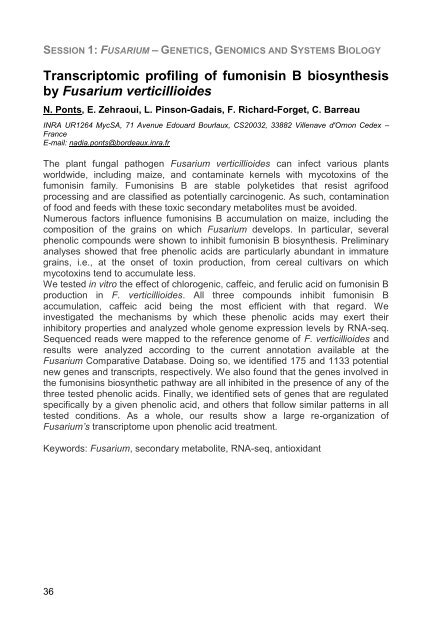EFS12- Book of abstracts - Contact
EFS12- Book of abstracts - Contact
EFS12- Book of abstracts - Contact
You also want an ePaper? Increase the reach of your titles
YUMPU automatically turns print PDFs into web optimized ePapers that Google loves.
SESSION 1: FUSARIUM – GENETICS, GENOMICS AND SYSTEMS BIOLOGY<br />
Transcriptomic pr<strong>of</strong>iling <strong>of</strong> fumonisin B biosynthesis<br />
by Fusarium verticillioides<br />
N. Ponts, E. Zehraoui, L. Pinson-Gadais, F. Richard-Forget, C. Barreau<br />
INRA UR1264 MycSA, 71 Avenue Edouard Bourlaux, CS20032, 33882 Villenave d'Ornon Cedex –<br />
France<br />
E-mail: nadia.ponts@bordeaux.inra.fr<br />
The plant fungal pathogen Fusarium verticillioides can infect various plants<br />
worldwide, including maize, and contaminate kernels with mycotoxins <strong>of</strong> the<br />
fumonisin family. Fumonisins B are stable polyketides that resist agrifood<br />
processing and are classified as potentially carcinogenic. As such, contamination<br />
<strong>of</strong> food and feeds with these toxic secondary metabolites must be avoided.<br />
Numerous factors influence fumonisins B accumulation on maize, including the<br />
composition <strong>of</strong> the grains on which Fusarium develops. In particular, several<br />
phenolic compounds were shown to inhibit fumonisin B biosynthesis. Preliminary<br />
analyses showed that free phenolic acids are particularly abundant in immature<br />
grains, i.e., at the onset <strong>of</strong> toxin production, from cereal cultivars on which<br />
mycotoxins tend to accumulate less.<br />
We tested in vitro the effect <strong>of</strong> chlorogenic, caffeic, and ferulic acid on fumonisin B<br />
production in F. verticillioides. All three compounds inhibit fumonisin B<br />
accumulation, caffeic acid being the most efficient with that regard. We<br />
investigated the mechanisms by which these phenolic acids may exert their<br />
inhibitory properties and analyzed whole genome expression levels by RNA-seq.<br />
Sequenced reads were mapped to the reference genome <strong>of</strong> F. verticillioides and<br />
results were analyzed according to the current annotation available at the<br />
Fusarium Comparative Database. Doing so, we identified 175 and 1133 potential<br />
new genes and transcripts, respectively. We also found that the genes involved in<br />
the fumonisins biosynthetic pathway are all inhibited in the presence <strong>of</strong> any <strong>of</strong> the<br />
three tested phenolic acids. Finally, we identified sets <strong>of</strong> genes that are regulated<br />
specifically by a given phenolic acid, and others that follow similar patterns in all<br />
tested conditions. As a whole, our results show a large re-organization <strong>of</strong><br />
Fusarium’s transcriptome upon phenolic acid treatment.<br />
Keywords: Fusarium, secondary metabolite, RNA-seq, antioxidant<br />
36
















![Présentation CRB-anim [Mode de compatibilité] - Inra](https://img.yumpu.com/17418636/1/190x135/presentation-crb-anim-mode-de-compatibilite-inra.jpg?quality=85)